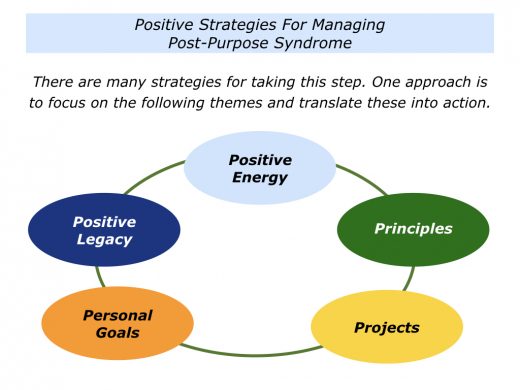
People love to have a sense of purpose. A person may strive to win a gold medal, sell a business, write a book or reach retirement. They work hard and feel exhilarated when achieving their goal.
The sense of satisfaction may last for a while, but then something else can happen. It may be replaced by a feeling of emptiness, even one of angst. The person’s sense of purpose has disappeared. What can they do next?
During the past 50 years I have worked with many people who have gone through this process. The good news is that, perhaps after a difficult time, they often emerge stronger and even feel more at peace.
Looking at your own life, can you think of a time when you managed a post-purpose situation successfully? This could have been in your personal or professional life.
You may have done so after running a marathon, passing an exam, publishing a book or achieving a long-term goal. You may have done so after feeling fully alive when tackling a specific challenge but then returning to daily life and feeling numb.
You may have done so after achieving certain career goals and getting regular promotions. Looking from the outside, your career appeared to be successful. But then you reached a point in your life where you said: “Is that it?”
You may have done so after spending many years working in an organisation. Still feeling semi-institutionalised, it took time to readjust. You eventually learned to follow your own rhythm, however, rather than that of the organisation. This led developing a new sense of purpose.
Looking back, how did you manage the post-purpose situation? How did you demonstrate a positive attitude? How did you set new goals? How did you encourage yourself? How did you achieve a sense of success?
If you wish, try tackling the exercise on this theme. This invites you to do the following things.
Describe a situation in the past when you managed the post-purpose syndrome successfully.
Describe the specific things you did to manage it successfully.
Describe the specific things that happened as a result.
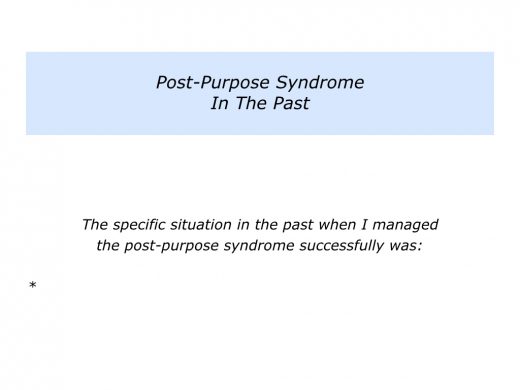
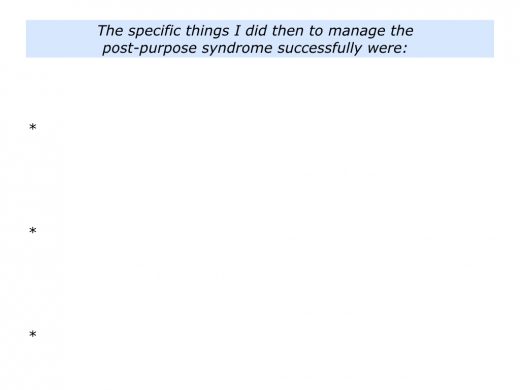
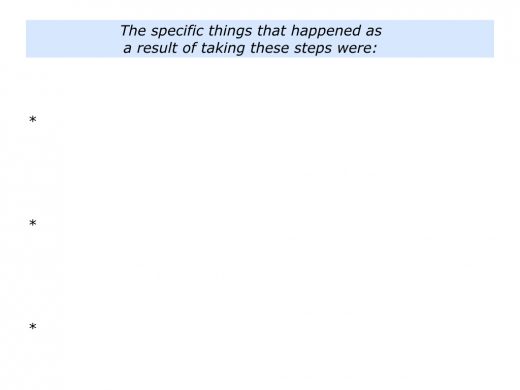
There are many strategies for managing post-purpose situations successfully. One is for a person to give themselves permission to rest before tackling the next challenge.
This is a strategy used by some peak performers who have been in a state of flow. They have felt high when competing in an event, playing on stage or performing at their best.
Coming out of this state can lead to restlessness. They long to return to feeling fully alive. Sometimes it can be appropriate for them to embark on the next challenge. One other occasions it can be useful for them to stay fallow for a while.
During this time the person can rest, reflect and revitalise themselves. When appropriate, they can research what they want to do next. Switching into full attention mode, they can then refocus and rehearse pursuing the next challenge.
Different people choose different ways to revitalise themselves. Some do things that give them positive energy. Some follow their principles.
Some focus on their passions and translate these into doing specific projects. Some work towards their personal goals. Some aim to leave a positive legacy. The following sections explore these themes.
Positive Energy
Imagine you are mentoring a person who wants to find a renewed sense of purpose. One approach is to try to help them to rediscover a deep sense of meaning. Sometimes this can work, but on other occasions it can take longer to settle on their chosen path.
Another approach is to invite the person to focus on the things that give them positive energy. This can lead to them feeling alive and exploring new dimensions. Serendipity then sometimes come along and presents them with a fresh sense of purpose.
Why take this approach? Energy is life. Bearing this in mind, it can be useful to encourage the person to clarify the things they give them positive energy in their personal and professional life. Here are the answers that people when doing this exercise.
Positive Energy
The things that give me positive energy
in my personal or professional life are:
Being with our children … Encouraging people … Running … Gardening … Being near water … Singing in the choir … Taking walks by myself … Playing the guitar … Cooking for our family … Caring for our horse … Sleeping deeply.
Helping people find satisfying work … Doing exciting projects … Teaching wellbeing … Designing pioneering products … Leading motivated teams … Fixing certain kinds of problems … Mediating disputes … Working on new ways to treat cancer.
Imagine that a person has produced such a list. You can then encourage them to do more of these things. This can have several benefits.
The person is more likely to feel alive and get their creative juices going. They may also be more positive and encouraging towards their loved ones and the people around them.
Sometimes serendipity strikes and can bring a renewed sense of purpose. This is what happened with one of my mentees. She moved from a digital marketing company to leading an educational organisation.
Tired of agency work, she wanted to help people to shape their futures in a fast moving world. She began by looking at traditional charities but soon began exploring social enterprises. Technologically savvy, she attended various conferences about helping people to develop their learning skills in a digital age.
She became particularly interested in the so-called Four C’s of Twenty-First Century Skills. These are Critical Thinking, Creativity, Collaboration and Communication. Like many people who attend conferences, at one point she saw a gap in the market and said: “I could do that.”
Building on her network in the digital space, she pioneered a project that helped employees to apply the Four C’s in their daily work. This enabled them to develop their skills and also build a learning organisation.
Being a good marketer, she publicised the benefits in a series of success stories. These stories were seen by the Board of an educational organisation that wanted to revolutionise its offering. She is now the Chief Executive of that organisation.
Let’s return to the person you may be mentoring. If appropriate, you can encourage them to do the things that give them positive energy. This will produce benefits for both themselves and for other people.
Here is an exercise that it can be useful for them to explore. They can then translate the ideas into action in their personal and professional life.
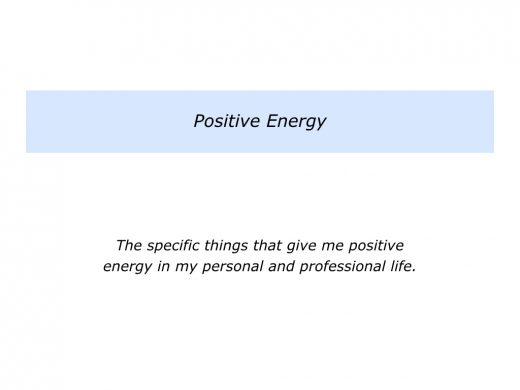
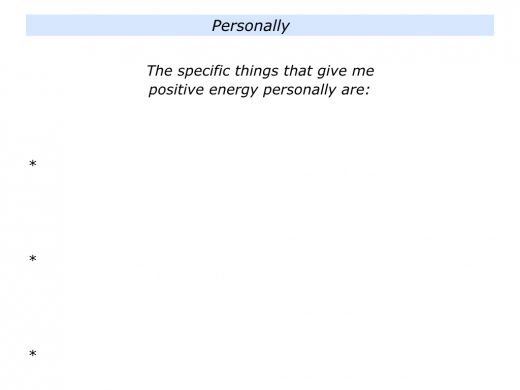
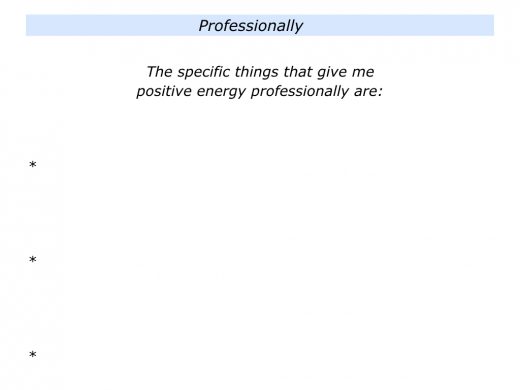
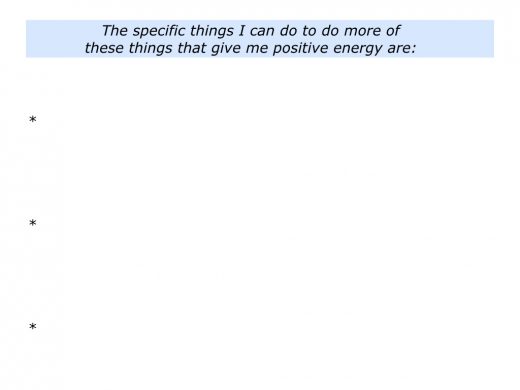
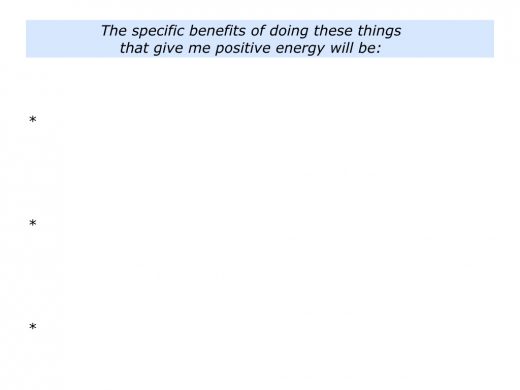
Principles
Let’s consider another strategy for managing post-purpose situations successfully. Several months ago I was contacted by somebody who wanted to explore their next step. They began by providing the following introduction.
Twelve months ago I sold my business, which is related to Formula 1 racing. This was something I had been working toward for several years.
After taking time out with the family, I returned to work and have done several consultancy projects. At the same time, I have explored several business ideas.
So far have not found the next ‘big thing’. This is frustrating and I am beginning to wonder if I will ever find something as compelling as the business I sold. Have you any suggestions?
Sometimes it can be hard for somebody to find another compelling purpose. Bearing this in mind, we took a different approach that often proves fruitful.
We focused on the principles he wanted to follow in his life.
Many people find it simpler to define these principles than define their life purpose. They can then pursue these principles in both personal and professional situations.
Such individuals often set aside time to re-centre. Looking ahead, they rehearse how to follow their principles in a specific situation. Clicking into action, they do their best to follow their principles in the personal or professional situation.
They then return to their centre, relax and refocus. This enables them to keep drawing strength from the central beliefs in their life. They then explore how they can follow their principles in the next situation.
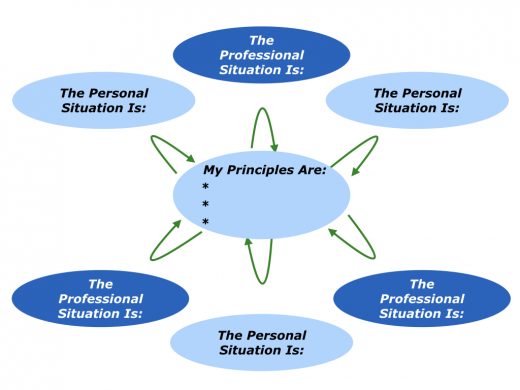
Different people describe different principles when exploring this approach, but several themes often recur. These include the following:
Being grateful … Being kind … Encouraging other people … Continuing to develop … Living fully … Helping to build a better world … Leaving a positive legacy.
The person who sold his business touched on some of these themes but expressed these in different ways. Being an adrenaline driven person, he was quite active and wanted to feel fully alive.
People develop, they seldom change. It was therefore about helping him to channel his personality rather than change his personality. Bearing this in mind, we focused on the principles he wanted to pursue in his life. After some discussion he settled on the following themes.
My Principles
I want:
To keep supporting my loved ones and also encourage other people;
To feel alive, stretch myself and fulfil my potential;
To build pioneering things that show people a better way and help them to achieve peak performance.
Looking ahead, we explored how he could follow these principles. This led to him making a clear action plan. Here are some points from the steps he aimed to take.
My Principles
The specific things I can do
to follow my principles are:
To encourage our children to pursue their interests and navigate the school system – because they are dyslexic and have talents not recognised at school – plus provide emotional support for my partner;
To train for and participate in an Iron Man event – because this will help me to keep fit plus satisfy my drive to stretch myself and go into new dimensions;
To pursue one of the business projects I find stimulating and deliver the first proof of concept – because this will satisfy my need to build things – plus act as a mentor at the university sponsored incubator for new businesses.
A proactive person at heart, he looked forward to translating these ideas into action. One challenge he faced, however, was to channel his restlessness in a positive way.
He loved to strive and achieve success. Sometimes he would feel a temporary sense of peace – perhaps for a few minutes – but this would not last long. He then wanted to find the next stimulating challenge.
The key would be for him to accept his personality. Maybe he could learn to stretch the sense of peace out longer and appreciate what he had in life. But he would always want to tackle stimulating challenges. Maybe the sense of peace would come from accepting this fact.
There are many ways to help a person to clarify the principles they want to follow in life. Sometimes they gain a sense of purpose by translating these into practise every day. Here is the exercise they can tackle on this theme.
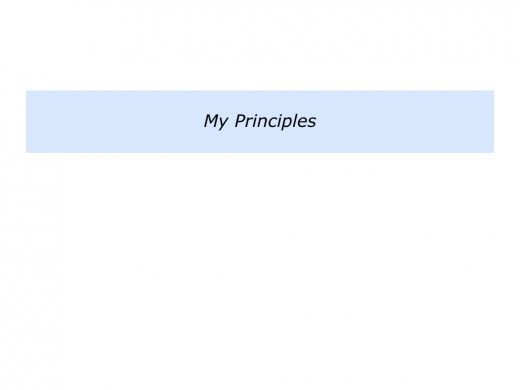
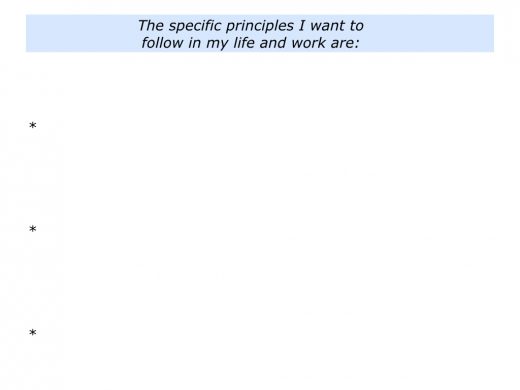
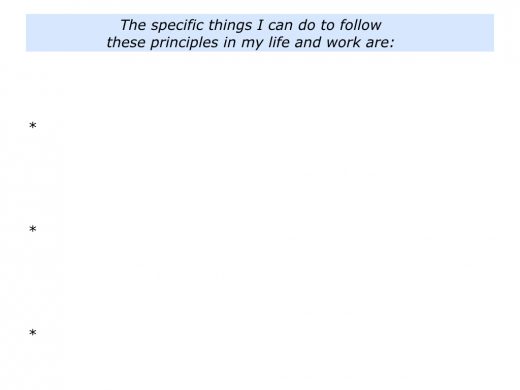
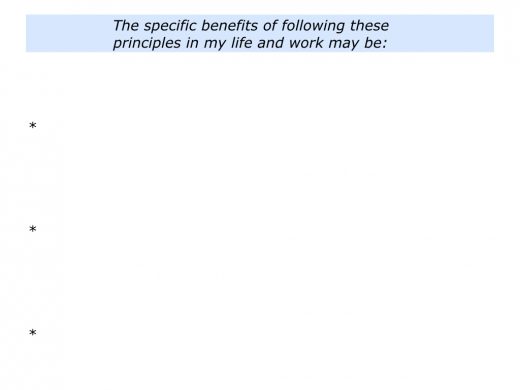
Projects
Let’s consider another strategy for managing post-purpose situations successfully. This is for a person to focus on something they feel passionately about and translate this into doing a specific project.
Imagine you want to pursue this approach in your own life. The first step is to describe some of the things you feel passionately about. These could be in your personal or professional life.
You may feel passionately about encouraging people, creating beauty, caring for animals or passing on knowledge. You may want to help people improve their wellbeing, find satisfying work or have access to clean water. You may feel passionately about another activity or believe in a particular cause.
Here we are talking about a passion you would like to pursue. It does not mean you will be the world’s best at the activity. You would like to follow this passion, however, and translate it into helping people or the planet.
Richard Feynman, the professor of physics, encouraged people to take this approach. He believed that sometimes this exploration may take us into different dimensions. The key was to keep learning and, if appropriate, pass on this knowledge to other people.
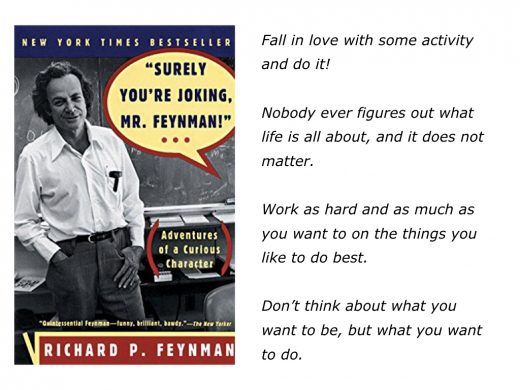
Mary Gordon translated her compassion for people into creating the organisation called Roots of Empathy. Its mission is to build caring, peaceful and civil societies through the development of empathy in children and adults.
The programme involves bringing a local baby into the classroom. The children then learn how to understand and care for the needs of another human being.
The Roots of Empathy programme has spread to many countries. It has produced remarkable results in enabling children to become more caring. This has also helped to reduce aggression, bullying and other social problems. You can discover more on the organisation’s web site.
http://www.rootsofempathy.org/
Imagine you want to channel your passions in a positive way. One approach is start by brainstorming the things you feel passionately about and then settle on one you want to pursue. You can then focus on how to translate this into doing a specific project.
You may aim to write an article, provide counselling sessions, run a workshop, give a concert or create a beautiful garden. You may aim to work for justice, invent a product, build a successful prototype or do another activity.
Looking ahead, you can clarify the specific things you can to do implement the project successfully. It can also be useful to clarify the benefits of doing such a project. Here is an exercise on this theme.
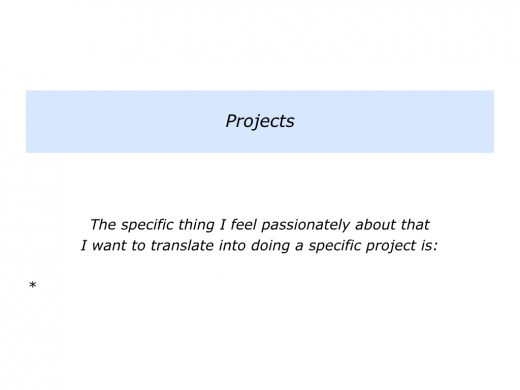
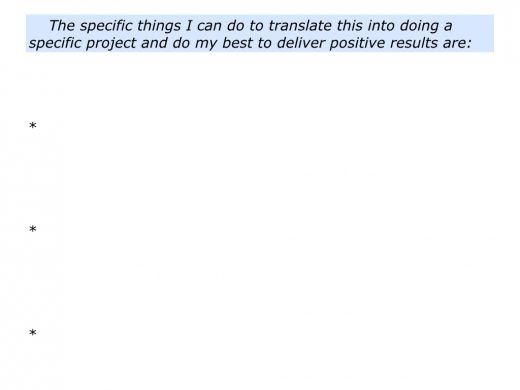
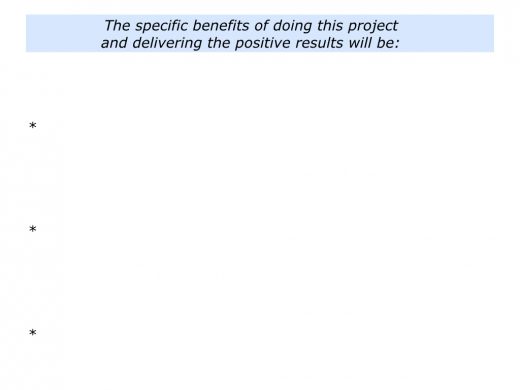
Personal Goals
Let’s consider another strategy for managing post-purpose situations successfully. This is for a person to focus on working towards their personal goals.
Imagine that you are mentoring a person who wants to take this approach. There are many ways that you can help them work towards their life goals.
You may begin, for example, by doing one of the classic exercises that helps a person to clarify their aims. If you wish, it can be good to do this yourself so you know the kinds of themes that may emerge.
My Picture Of Success
Everybody is different and has different pictures of success. A person may want to raise a happy family, help other people or do satisfying work. They may want to maintain a sense of gratitude, feel at peace or leave a positive legacy.
Looking back on your life in future years, what do you want to have done that for you will mean you have had a successful life? One approach is to start from your destination and define your overall life goals. People often cover three themes when taking this approach.
Positive Relationships
People often talk about how they want to be remembered as a parent, partner, friend or whatever. A person may say, for example:
I want my partner and I to have given our children the opportunity to enjoy a happy childhood. For example, I want them to say things like:
“Our parents were always there for us. They encouraged us, helped us to develop our talents and also learn how to make good decisions.”
Positive Experiences
People often focus on how they want to enjoy life, pursue experiences and have no regrets. A person may say something like:
I want to feel I have lived life fully and that I have done my best.
I want to have visited many countries, to have completed the book I promised myself I would write and to have made full use of my talents.
Positive Contribution
People often talk about wanting to make a positive contribution to the world. This may involve them following their vocation or doing something that improves life for other people. A person may something like the following.
I want to have used my talents to do satisfying work that has helped other people.
For example, I want to have … to have … to have …
Clarifying these goals can act as a long-term compass and you can bear this in mind when making key decisions. When given the opportunity to take a new job, for example, you can ask yourself:
Will taking this step help me to achieve my longer-term picture of success?
Momentum is crucial. So it can be useful to do one thing early each day towards achieving your life goals. This helps to provide a sense of meaning to the day and also means you are working towards achieving your long-term picture of success.
Here is a classic exercise on this theme. You will, of course, adapt it in your own way.
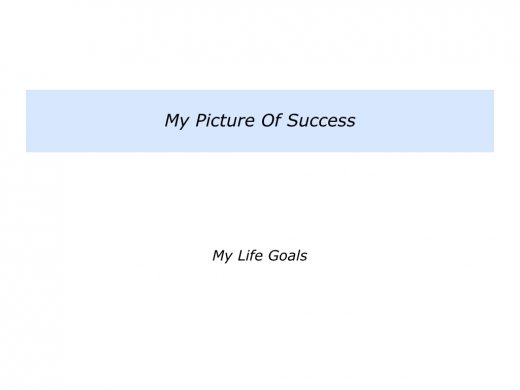
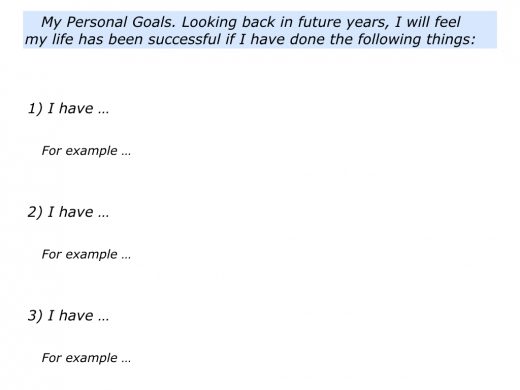
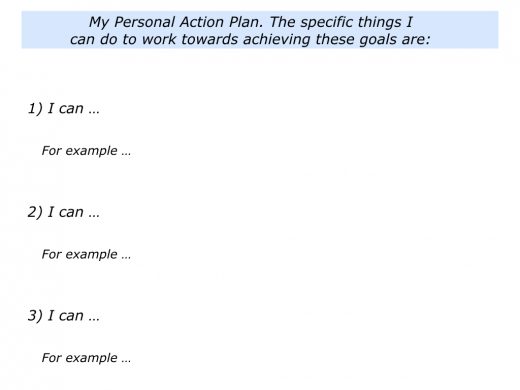
Positive Legacy
Today it is more common for people to talk about leaving a legacy. It can be important for them to leave a positive legacy, however, rather than a negative legacy.
Different people want to leave behind different things. Sometimes they pass on ideas, works of art, buildings, businesses or other tangible things. Sometimes the legacy is on a more emotional or ethical level.
People often create a legacy that revolves around the principles they pass on to other people.
They may aim to create a family, school, sports team, work place, business or other environment. They may also aim to act as positive models and embody certain principles.
The emotional and ethical legacy they create stays with other people. Many years later somebody who was in the environment may look back and say something like the following.
We were encouraged to follow certain principles in our daily lives and work. I now try to follow these principles and pass them on to other people.
How to clarify the kind of legacy you want to create? One approach is to describe the positive things you want to give to people during your time on the planet.
Different people mention different themes when doing this exercise. Here are some of the answers they give.
My Positive Legacy
The positive things I want to give to
people during my time on the planet.
I want:
To give my family a loving home … To give people encouragement … To give my students hope … To give people nourishing food … To show people how they can take care of their health … To show people how to make use of their talents.
To give people tools they can use to build great organisations … To give people models they can use to build successful and sustainable systems … To pass on knowledge that helps both present and future generations.
Some people experience an interesting realisation when doing this exercise. They realise that the things they want to give to others may mirror the things they have been given in life. Some build on what they have written and translate this into a clear purpose.
If you wish, try tackling the exercise on this theme. This invites you to describe the positive things you want to give to people. If appropriate, you can then aim to translate these ideas into action in your daily life and work.
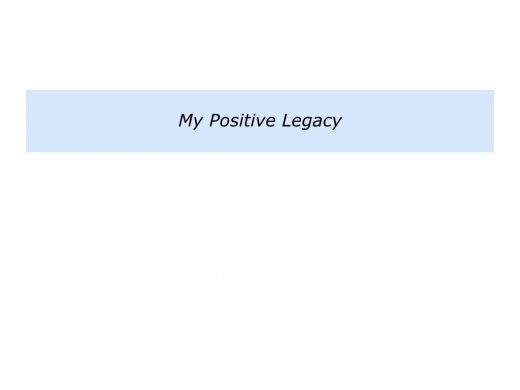
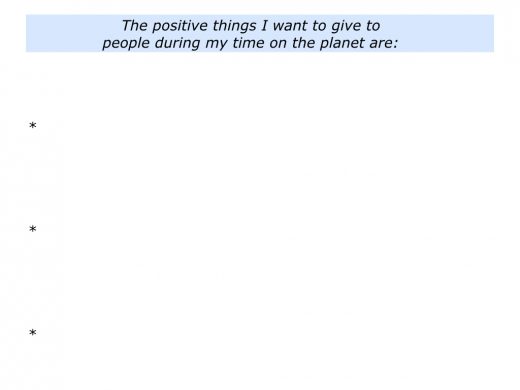
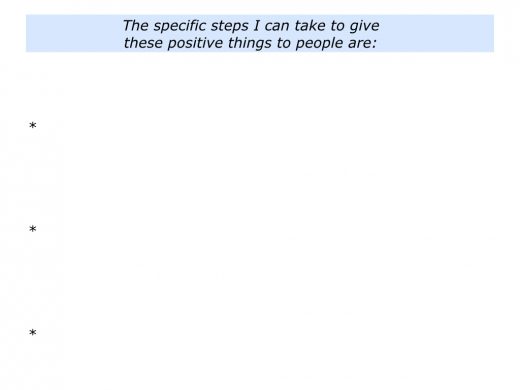
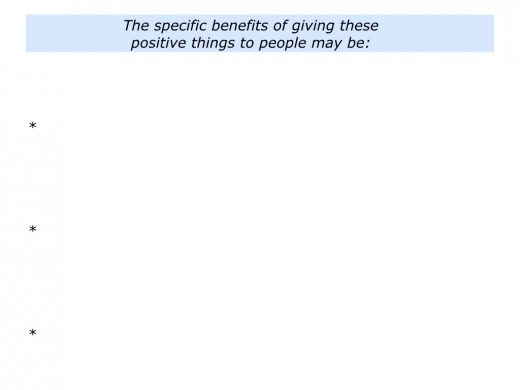
There are many strategies for managing post-purpose situations successfully. Here we have focused on the themes of positive energy, principles, projects, personal goals and leaving a positive legacy.
Looking ahead, can you think of a situation when you may want to use some of these or your own strategies? This could be in your personal or professional life.
You may wish to do so after doing a creative project, tackling a tough challenge or reaching a specific goal. You may wish to do so after your children leave home, retiring from full-time work or making another transition.
How can you rest and revitalise yourself? How can you do things that give you positive energy? How can you set specific goals and get a feeling of success? How can you develop a new sense of purpose?
If you wish, try tackling the exercise on this theme. This invites you to do the following things.
Describe a situation in the future when you may want to manage post-purpose syndrome successfully.
Describe the specific things you can do to manage it successfully.
Describe the specific things that may happen as a result.
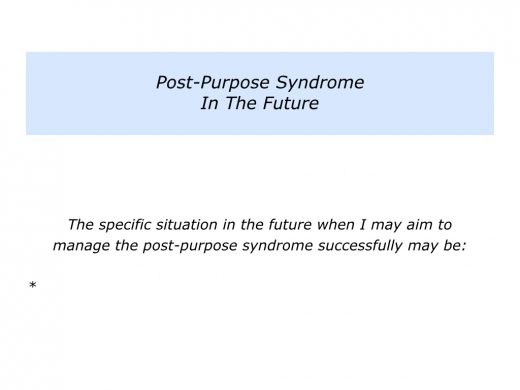
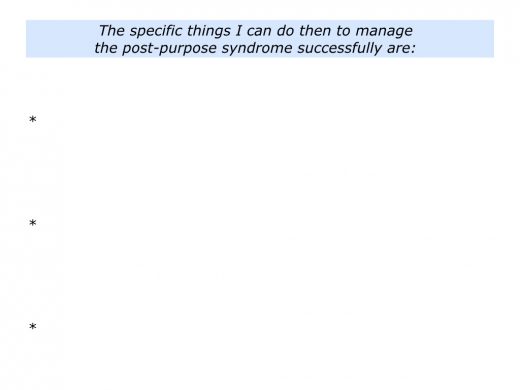
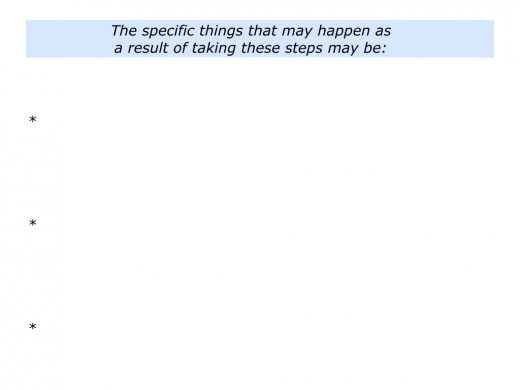






Leave a Reply